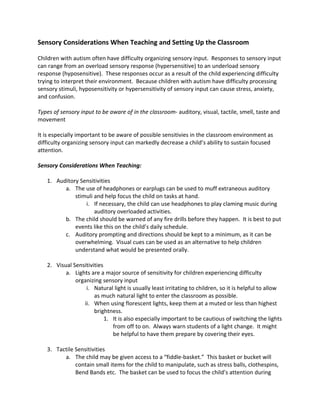
Sensory Considerations When Teaching and Setting Up the Classroom
- 1. Sensory Considerations When Teaching and Setting Up the Classroom Children with autism often have difficulty organizing sensory input. Responses to sensory input can range from an overload sensory response (hypersensitive) to an underload sensory response (hyposensitive). These responses occur as a result of the child experiencing difficulty trying to interpret their environment. Because children with autism have difficulty processing sensory stimuli, hyposensitivity or hypersensitivity of sensory input can cause stress, anxiety, and confusion. Types of sensory input to be aware of in the classroom- auditory, visual, tactile, smell, taste and movement It is especially important to be aware of possible sensitivies in the classroom environment as difficulty organizing sensory input can markedly decrease a child’s ability to sustain focused attention. Sensory Considerations When Teaching: 1. Auditory Sensitivities a. The use of headphones or earplugs can be used to muff extraneous auditory stimuli and help focus the child on tasks at hand. i. If necessary, the child can use headphones to play claming music during auditory overloaded activities. b. The child should be warned of any fire drills before they happen. It is best to put events like this on the child’s daily schedule. c. Auditory prompting and directions should be kept to a minimum, as it can be overwhelming. Visual cues can be used as an alternative to help children understand what would be presented orally. 2. Visual Sensitivities a. Lights are a major source of sensitivity for children experiencing difficulty organizing sensory input i. Natural light is usually least irritating to children, so it is helpful to allow as much natural light to enter the classroom as possible. ii. When using florescent lights, keep them at a muted or less than highest brightness. 1. It is also especially important to be cautious of switching the lights from off to on. Always warn students of a light change. It might be helpful to have them prepare by covering their eyes. 3. Tactile Sensitivities a. The child may be given access to a “fiddle-basket.” This basket or bucket will contain small items for the child to manipulate, such as stress balls, clothespins, Bend Bands etc. The basket can be used to focus the child’s attention during
- 2. time when the teacher is lecturing or reading aloud. 4. Taste and Smell Sensitivies a. Children should bring their own lunch and snack in order to avoid any special taste sensitivities. b. Teachers should take care to avoid any pungent or fragrant odors or perfume in order to avoid an olfactory sensitivity. 5. Movement Sensitivies a. Classroom transitions such as going to/from lunch, going to/from recess, changing class periods etc. can be difficult for some children. It can be helpful to allow a child to leave earlier to later that the rest of the students. **Use of a “quiet space/area” can be an option for students to go when they feel overwhelmed by any stimulus. This space can be used to decrease sensory overload and increase self- calming. This space should be clearly marked and contain objects that are calming to the child. Setting up the Classroom: The physical structure of the classroom can provide environmental organization for student with autism. Clear physical and visual boundaries can be helpful to clarify where one space ends and another begins. Physical structure can also be used to minimize visual and auditory distractions. Common Classroom problems: 1. Large, wide-open spaces can be difficult for children with autism. a. Clear boundaries can be defined by arranging furniture, the use of carpet squares, or utilization of colored tape. i. Boundaries can help a child organize what happens in each area of the room, where the areas begin and end, as well as how to get to the area by the most direct route. 2. Classrooms often contain many visual distractions. a. Painting the walls and ceiling of a classroom a muted color can help reduce distraction. b. Sheets and curtains can be used to cover shelves that display classroom materials can help reduce distraction i. Sheets or curtains can also be used to cover equipment like computers or TVs when not in use. c. Storing material in a closed closet or additional room can also reduce classroom distraction. d. Controlling the amount of light entering a classroom with blinds, shades, or
- 3. curtains can reduce the distraction of lighting. 3. Classrooms often contain auditory distractions. a. Using carpeting, lowered ceilings, acoustical tiles, or placing foam around the PA system can reduce auditory distractions. 4. Disorganization can be distracting to children with autism. a. Children with autism require a structured environment. Organization and knowledge of how the classroom is organized will help a child be able to navigate the classroom on a daily basis. b. Visual schedules placed in a central location will also help the child mentally organize the day’s activities. References: http://www.specialed.us/autism/structure/str10.html http://www.specialed.us/autism/asper/asper12.html Written by Susan Stokes under a contract with CESA 7 and funded by a discretionary grant from the Wisconsin Department of Public Instruction.
